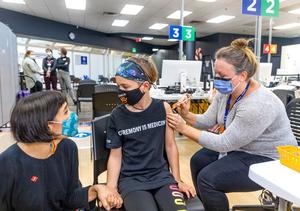image:
A multilevel analysis of factors related to COVID-19 vaccination rates calls for improvements in healthcare policy in the United States.
view more
Credit: BC Gov Photo from Openverse
COVID-19 vaccines introduced in December 2022 have played a key role in reducing pandemic-related mortality and morbidity globally. However, by 2023, only 70% of the US population had completed the primary vaccination series. Factors such as race/ethnicity, socioeconomic status, geography, and political affiliation have been associated with vaccination rates, but their relationship to characteristics of health care delivery settings, such as community health centers (CHCs), has not been investigated. . CHCs play an important role in health care delivery, providing comprehensive primary care, including COVID-19 vaccines, to low-income populations.
Recently study Published in American Journal of Public HealthRachel Gold, Ph.D., of OCHIN, Inc., Kaiser Permanente Center for Health Research, Asian Health Services, and colleagues evaluated the multilevel factors influencing COVID-19 vaccination rates across the U.S. CHC network. “We describe site- and patient-level characteristics associated with COVID-19 vaccination across a national network of CHCs, which can inform future vaccination efforts in CHC-served populations. Provide knowledge. ” Dr. Rachel Gold, lead author of the study, explains:
Researchers analyzed electronic health records from OCHIN, a nonprofit health equity innovation center. They investigated CHC-related factors such as location (rural or urban), Medicaid expansion, and patient volume, along with patient-level factors such as gender, race, income, and insurance status. The study also took into account comorbidities such as diabetes and obesity. All patients were stratified into “new” and “established” patients based on the number of times the patient visited the CHC up to January 2021. Multiple-level regression analysis was performed to assess the contribution of these factors to initial treatment completion for COVID-19. vaccination.
This analysis included 1,219 healthcare facilities and 1,864,007 patients, with 72% of this population vaccinated by the end of 2022, exceeding the 69% completion rate for the general U.S. population at that time. It became clear that Of note, 89% of new patients have been vaccinated compared to 69% of existing patients, with CHCs serving as the primary access point to vaccines. It shows that there is. “This suggests that many new patients established care at these sites primarily to access the COVID-19 vaccine after it became widely available in January 2021. Masu. ” Dr. Gold says:
The decline in vaccination rates was particularly pronounced among established patients in states that have not expanded Medicaid. These findings highlight the challenges faced by patients in non-Medicaid expansion states, with access to health services, including vaccines, remaining a key issue and the need to address these disparities and provide access to essential care. This points to the need for policy interventions that can improve access.
The study further highlighted disparities based on socio-economic and racial factors. Patients from low-income backgrounds, rural areas, and patients who identified as Black/African American had lower vaccination rates than patients of White or Asian descent. Additionally, those with private insurance were more likely to receive the vaccine than those with Medicaid or no insurance. “These results are consistent with previous studies showing lower vaccination rates among socioeconomically disadvantaged populations, Medicaid recipients, and the uninsured.” Dr. Gold.
This study establishes the importance of CHCs as critical access points for COVID-19 vaccination, especially for new patients. The clinical practice and patient-related factors that influenced vaccination completion rates in this study warrant policy modifications at the state and national level to ensure improved vaccination rates in the future.
journal
American Journal of Public Health
Research method
Data/statistical analysis
Research theme
people
Article title
Healthcare delivery site and patient-level factors associated with completion of the COVID-19 primary vaccine series in a national network of community health centers.
Article publication date
October 2, 2024
Conflict of interest statement
The authors report no conflicts of interest.
Disclaimer: AAAS and EurekAlert! We are not responsible for the accuracy of news releases posted on EurekAlert! Use of Information by Contributing Institutions or via the EurekAlert System.

